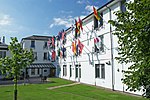Keats House

Keats House is a writer's house museum in what was once the home of the Romantic poet John Keats. It is in Keats Grove, Hampstead, toward the edge of inner north London. Maps before about 1915 show the road with one of its earlier names, John Street; the road has also been known as Albion Grove. The building was originally a pair of semi-detached houses known as "Wentworth Place". John Keats lodged in one of them with his friend Charles Brown from December 1818 to September 1820. These were perhaps Keats's most productive years. According to Brown, "Ode to a Nightingale" was written under a plum tree in the garden. While living in the house, Keats fell in love with and became engaged to Fanny Brawne, who lived with her family in the adjacent house. Keats became increasingly ill with tuberculosis and was advised to move to a warmer climate. He left London in 1820 and died, unmarried, in Italy the following year. The house is a Grade I listed building.
Excerpt from the Wikipedia article Keats House (License: CC BY-SA 3.0, Authors, Images).Keats House
Keats Grove, London Belsize Park (London Borough of Camden)
Geographical coordinates (GPS) Address Nearby Places Show on map
Geographical coordinates (GPS)
| Latitude | Longitude |
|---|---|
| N 51.5555 ° | E -0.1682 ° |
Address
Keats Community Library
Keats Grove 10
NW3 2RR London, Belsize Park (London Borough of Camden)
England, United Kingdom
Open on Google Maps











